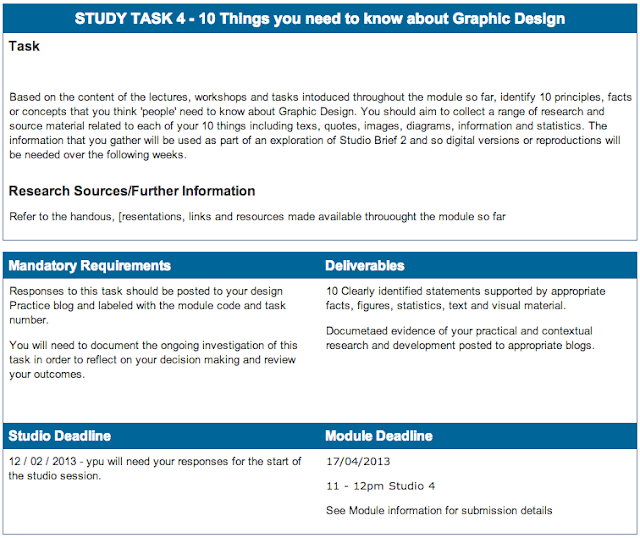This is another live brief, and the final product of this brief will be given to the new first years in their first week, you can see a copy of the brief which we were given below.
For friday, the 22nd of March, 3 boards, one with a concept, one with a method of delivery and one of with production. Boards are to be no smaller than A3 size, printed off.
Audience: New 1st Years, 18-25. Typically, confused and overwhelmed with power point presentations.
Concept: For the content, I'm interesting in providing the recipient with useful information to optimise their productivity and methods so they can create a high quality standard of work slightly quicker than the conventional methods, with more efficiency. For example, I would recommend apps for their macs which would act as a note book, for examples Evernote, which is a notebook app, it stores and categorises your documents in a clean and easy to navigate format, which separates your notes into 'notebooks', which you can tag for ease of search. They also work well in sync with other Evernote apps on other user interfaces, such as iPads and iPhones, incase you're caught short without your Mac. The advantage to working with this app above direct blogging would be that this app works well offline, so you can pull up notes in wi-fi dead zones and has a nicer interface. You can copy your notes over to blogger simply using the copy and paste tools. You can also share your notes to Twitter, Facebook or LinkedIn and you can e-mail them. I could essentially review them and says specifically how they can be applied to optimise efficiency, and show the audience, the new first years, briefly how to use them.
This part of the module will have an massive effect on the module grade, this needs to be good, and it needs to look like Graphic Design and you need to think about production.
Method of Delivery: Following my research on my design context blog, I've decided to create sleeve which will hold all the information in, which consists of a small dictionary in book format and 3 flyers. One, which congratulates and welcomes the new student onto the course, one which provides the new students with the app guide and the final one, which is the tips guide. You can see a concept sketch of the sleeve below.
For the first crit, on friday the 22nd of March, before we break up for easter, we were asked to produce these research boards. One which defines the concept, what we want to communicate and why, the second, states our method of delivery, how we plan on delivering our message, for me, that is a sleeve with the flyers, leaflets and book inside it, as you can see in the design sheet above. The third sheet is Production, how we plan on creating our method of delivery. For me, I plan on binding the book using strings of fiber, and thread to hold it together, and cardboard with cloth over the top for the front and back cover.
Above, you can see the concept design for the book. It will either be bound using a sewing method which I've mocked up, you can see below, or a perfect bind method.
I began by creating three sets of four sheet of paper, folder and stacked like this. Piled the sets and compressed them under books for 24 hours. To decrease their size as much as I can, and almost solidify the folds.
I then begans to sew the paper sets together using this method, which would create this bind below, on the inside of the book.
I then compressed the binded book for another 24 hours, as you can see below. This would seal the bind, and allow it to set within the books.
I think this is a nice alternative to using a staple bind, and i'm glad with how my first attempt came out. However, to achieve a more professional look I'd have to go with a prefect bind, with a hard cover on the edge.
Since i've got the method of production sorted, I've begun to focus on layout and colour/type selection. I quickly mocked up some thumbnail sketched of how I want the spreads in the book to look.
I wanted to have a large feature type in a heavy block colour to draw the attention of the reader. Then using body copy to allow the reader to learn the definitions.
Above are some larger layouts which communicate exactly how I'd like them to look, as they're in 1:1 scale.



















